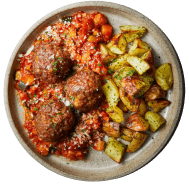A Low FODMAP dessert recipe.
Blood Orange Custard Tart
This tart is sunny citrus (gluten-free and low FODMAP!) heaven. Creamy, zingy orange custard just-set on a buttery sweet shortcrust pastry base. Finish with crème fraîche or lactose free yogurt and a grating of white chocolate.
For a deeper orange hue, make the most of the last of the blood oranges, or alternatively, use the best looking oranges you can get your hands on. Adding a small amount of lemon juice into the mix helps accentuate the oranges’ tartness in the most delicious way.
I’ve used whole eggs throughout the recipe instead of egg yolks, to save you from any leftover whites, and to make the tart a bit lighter (but no less delicious).
Serves 12
Ingredients
For the sweet shortcrust pastry:
200g gluten-free plain flour
1 teaspoon xanthan gum
1/2 teaspoon fine sea salt
3 tablespoons icing sugar
100g unsalted butter, cold and cut into cubes
1 medium free-range egg, whisked
For the filling:
190ml fresh orange juice (from about 4 oranges)
25ml lemon juice (from 1 large lemon)
190g lactose free cream
150g caster sugar
5 medium free-range eggs
To serve
Crème fraîche (keep to 1 tablespoon per serve) or lactose free yogurt
8 squares white chocolate
Method
Put the gluten free flour, xanthan gum, salt and icing sugar into the bowl of a food processor and blitz briefly to combine. Add the butter and pulse until the mixture resembles fine breadcrumbs. Whisk the egg and add it to the mix, pulsing until the dough starts to come together. If you don’t have a food processor, sift the flour, xanthan gum, salt and icing sugar into a large bowl and work the butter into the dry ingredients with your finger tips. Stir the egg into the butter/flour mix with a cutlery knife and bring the dough together.
Tip the pastry out onto cling film or baking paper and shape into a disc, touching the dough as little as possible, but making sure the dough is smooth and there are no cracks. Wrap tightly and chill in the fridge for two hours, or until firm.
Roll the chilled pastry out onto a clean, floured surface, to the thickness of a pound coin and get ready a 9 inch/23cm loose-bottomed fluted tart tin. Cut out a circle a little bigger than the tin and using your rolling pin, lift up the pastry and place it over the tart tin, gently pushing the pastry right into the edges. Cut off any excess pastry, leaving a small overhang. Place the pastry case in the freezer for 20 minutes to firm up. Preheat the oven to 190C/170C fan.
Use a sharp knife to trim off the excess pastry overhang and prick the base all over with a fork. Line the pastry case with greaseproof paper and fill with baking beans. Place the tart case on a baking tray and blind bake for 20 minutes, then remove the paper and baking beans and bake the tart case for another 10 minutes, or until the pastry is golden, sandy to the touch and has no grey patches. Remove the tart case from the oven and turn the oven down to 140C/120C fan.
To make the filling, put the orange and lemon juice, the cream and caster sugar into a medium saucepan.
Crack the eggs into a bowl and before whisking the eggs together, brush a little of the egg white over the cooked pastry case. Place back in the oven for a few minutes - this step helps seal the pastry - then remove once more.
Whisk the eggs together and add to the saucepan with the citrus juices. Cook over a very low heat until steaming, stirring gently to combine.
Remove the pan from the heat, pour the mixture through a sieve into a jug and remove any larger bubbles on the surface. Pour three quarters of the filling into the tart case - still on the baking tray - then place into the oven. Pour in the rest of the filling and close the oven door.
Bake for 30-35 minutes, or until just set with a little wobble in the middle. Timings can really vary depending on your oven, so just keep an eye. Let cool to room temp and then chill in the fridge for a couple of hours to finish setting completely. Serve with a few dollops of crème fraîche or lactose free yogurt and a grating of white chocolate.



















